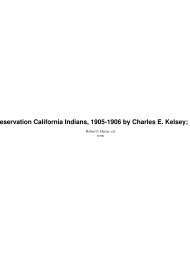Spring 2008 - Yosemite Conservancy
Spring 2008 - Yosemite Conservancy
Spring 2008 - Yosemite Conservancy
- No tags were found...
You also want an ePaper? Increase the reach of your titles
YUMPU automatically turns print PDFs into web optimized ePapers that Google loves.
BY JUN KINOSHITA<br />
A LEGACY OF FIRE<br />
LOOKING BACK TO LOOK FORWARD IN YOSEMITE VALLEY<br />
The landscape that awed early Euro-American visitors<br />
to <strong>Yosemite</strong> Valley was, and is, remarkable for<br />
a natural beauty seen nowhere else on earth. But<br />
as wild as that landscape looked, its untouched appearance<br />
was deceptive. Humans had used fire to manage the<br />
vegetation of the Valley for hundreds if not thousands of<br />
years. The open vistas onto El Capitan and Half Dome,<br />
the lush meadows, and the rich American Indian culture<br />
early Euro-American visitors encountered, were the<br />
result of a naturally fire-adapted ecosystem harnessed for<br />
human benefit.<br />
All across North America, from the deep eastern forests,<br />
to the Midwest’s broad prairies, to the steep slopes<br />
of the Sierra Nevada, the first human inhabitants had<br />
observed the effects of natural lightning-caused fire. They<br />
watched closely as entire ecosystems first seemed to succumb<br />
to the flames, then sprang back rejuvenated. Over<br />
time, these first peoples learned to harness the power of<br />
fire to shape the landscapes in which they lived. Historic<br />
accounts suggest that Native Americans lit wildland fires<br />
for many reasons: to herd game into elaborate traps,<br />
reduce opportunities for enemies to hide, encourage<br />
certain plants to grow, take away resources from enemies<br />
and cover retreats. While some of these effects were<br />
immediate, others suggest long-term planning and a deep<br />
understanding of complex ecosystems. Fires encouraged<br />
new growth the following season that would attract game,<br />
or straight growth in plant material used for baskets and<br />
tools. Fires set on a regular basis favored the growth of<br />
certain staple plant communities over others.<br />
A culture whose diet depended heavily on rich acorns<br />
would find advantage by encouraging oak growth in open<br />
meadows and reducing shade-tolerant species such as<br />
cedar and pine. Regular burning, they knew, would kill<br />
small, encroaching conifers and reduce the buildup of<br />
litter and duff that might fuel a hotter, more severe fire<br />
that could destroy oaks. For these reasons, cultural groups<br />
across North America, including the native inhabitants of<br />
<strong>Yosemite</strong> Valley, developed a knowledge base delineating<br />
when to burn, where to ignite and what effects fire might<br />
have on a given plant community. This information was<br />
the result of hundreds of years of observation intertwined<br />
into cultural traditions and practices, and passed down<br />
through the generations.<br />
The arrival of Spanish explorers into California, and<br />
then other Euro-Americans in the <strong>Yosemite</strong> region,<br />
challenged these cultural traditions. Diseases that raced<br />
BRENT JOHNSON, NPS<br />
ahead of actual contact decimated populations, changing<br />
cultural practices. After Euro-American contact, Native<br />
American lifeways were fundamentally altered. Efforts to<br />
protect the beauty of <strong>Yosemite</strong> Valley and other areas led<br />
to the suppression of all wildland fire. Later, as large tracts<br />
of land were set aside as preserves and national parks, the<br />
role of fire in ecosystems came to be reexamined.<br />
By the middle of the twentieth century, land managers<br />
had begun to observe disturbing changes to their parks<br />
and forests. Fires were becoming more severe and harder<br />
to control. Certain species of trees were being crowded<br />
out or were not reproducing. Some critical element was<br />
missing, and that element was fire. Concern for public<br />
safety and other factors meant that land managers could<br />
not allow fire to run freely across the landscape. But it<br />
became clear that fire had been, and needed to be, a part<br />
of the ecosystem that shaped the beauty of the landscape.<br />
From that realization came the start of a complex fire<br />
management program that now utilizes a variety of tools<br />
and techniques to protect infrastructure and visitors<br />
while allowing fire to play as natural a role in the ecosys-<br />
Smoke from the prescribed burn curls up past Half Dome.<br />
YOSEMITE ASSOCIATION, SPRING <strong>2008</strong><br />
7


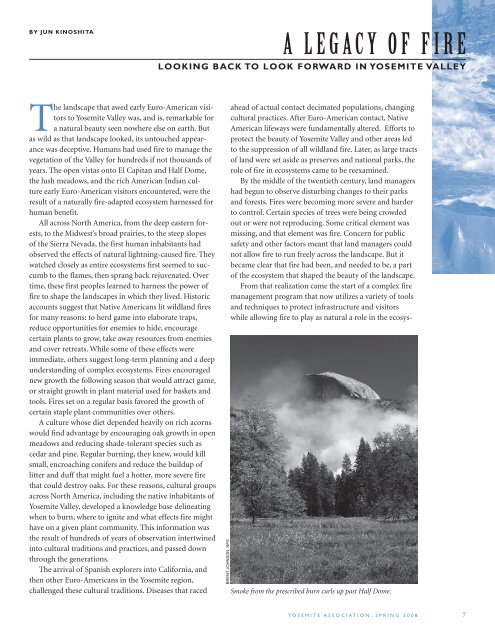

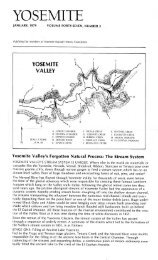
![(March 1982) [PDF] “We Are Pleased to Announce†- Yosemite Online](https://img.yumpu.com/51299748/1/190x242/march-1982-pdf-aeuroewe-are-pleased-to-announceaeur-yosemite-online.jpg?quality=85)
![[PDF] Old Horny, Yosemite's Unicorn Buck - Yosemite Online](https://img.yumpu.com/51269869/1/184x260/pdf-old-horny-yosemites-unicorn-buck-yosemite-online.jpg?quality=85)
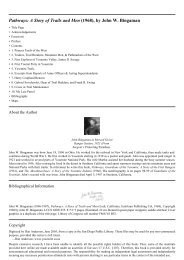
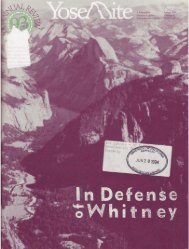
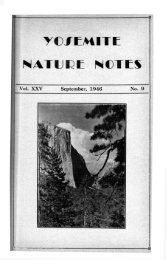
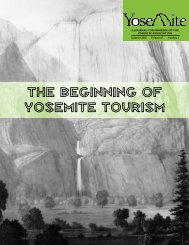
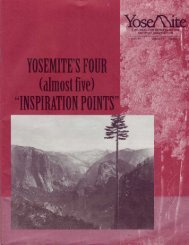
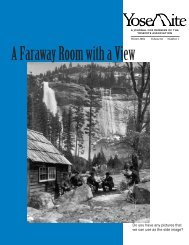
![1985 [PDF] - Yosemite](https://img.yumpu.com/48128837/1/184x260/1985-pdf-yosemite.jpg?quality=85)

